Animal Tracking: 10 Common Species
Animal Tracking: How to Identify 10 Common North American Species.
BY TIM MACWELCH
Animal Tracking: How to Identify 10 Common North American Species.
BY TIM MACWELCH
_______________
Learn how to read tracks, and you’ll learn a new language, one that communicates the hidden stories of the animals that leave the tracks. Our ancestors had to be adept in tracking to learn about the unseen game animals and predators in their vicinity. Today, animal tracking provides an invaluable service to the hunter and trapper, as well as the nature lover and photographer. Tracking can also be a lifesaver in a survival situation, warning you about dangerous creatures in the area and helping you to locate your next meal. Find a few clear prints and you’ll be able to read a few pages from the tale of that animal’s life. Find a trail, and you might just find the animal itself. Polish up your existing skills or learn a brand new one, with these tips on tracking 10 common species.
Track illustrations below from the Massachusetts Division of Fisheries & Wildlife
Note: Tracks not drawn to scale. F: Front Track; H: Hind Track; and T: Tail marks may be present.
Beaver
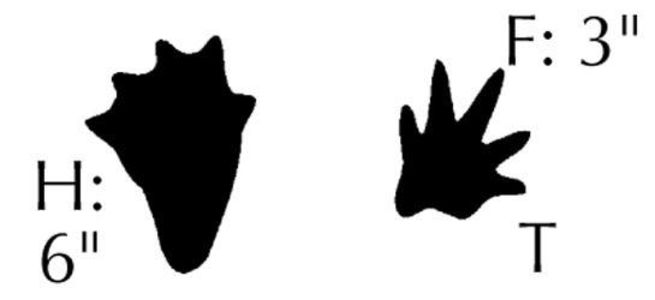
It’s easy to spot a beaver’s wooden lodge at a distance, or their tree felling work, but it’s a lot harder to find an obvious footprint from this water loving animal. Looking for larger beaver sign is a good place to start. Inspect areas with gnawed trees and maybe you’ll find a few tracks in damp soil. Check out the hills and banks that lead into the beaver’s waterway and you might find a beaver slide, a well-worn and often muddy run that terminates in the water. This is generally the beaver’s path back to the water, but not out of it. Still, it’s a likely spot to look for footprints.
A beaver’s front foot is very similar in size and shape to that of a raccoon, but the rear foot is unique. Five large, long toes may show signs of the webbing that circles the toe span. Front prints are about three inches long, while rear prints can be more than six inches in length. Expect to find beavers throughout the continental US and Canada, though they are rare in Nevada and southern California.
Eastern Cottontail Rabbit
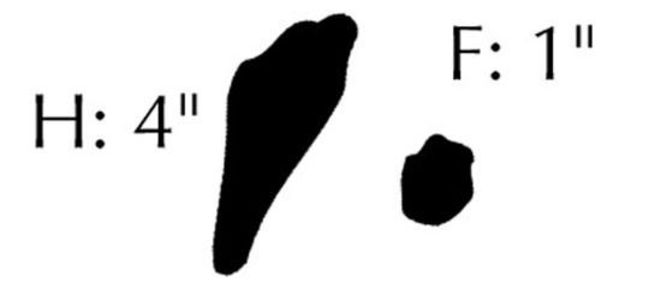
Hardly the burrow dwelling Peter Cottontail of our childhood literature, the eastern cottontail lives its life in the open, seeking shelter in the brush and weeds, rather than a deep den in the ground.
A single footprint from one paw may not tell you much about this animal or identify the species. Find a few sets of tracks, however, and you’ll know it’s a rabbit right away. Rabbits typically move in a gallop. The big rear feet hit the ground in front of the two small front feet when the rabbit is “walking” or running, and a trail looks like a series of “C”s or “V”s made by the four feet. Expect to find similar tracks and trails from snowshoe hares, jackrabbits, and other members of the rabbit family, Leporidae. Cottontail tracks generally have one-inch-long front feet and three-inch-long rear feet. The eastern cottontail can be found throughout the eastern half of the United States, and from Texas to North Dakota.
Raccoon
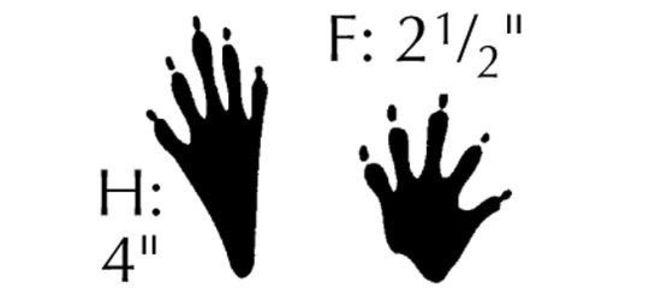
Mostly active at night, the raccoon is a fascinating omnivore to track. This scavenger can often leave long trails for you to follow through the mud and sand of wet areas. The front and rear footprints of a raccoon have an astonishing resemblance to a human handprint. Their nimble fingers are skillful at catching minnows and opening freshwater shellfish.
Look for the obvious five toes on each foot. Also look for all five of the toes to point forward, nearly parallel to one another. This will help you differentiate raccoon footprints from the wide-splayed toes of the opossum and the rarely imprinted fifth toe of a muskrat. Raccoons move in a diagonal track pattern, just like a deer. Watch for the longer heel of the rear foot to tell the front foot from the back foot. Raccoon front footprints are 2 to 3 inches long, and 3 to 4 inches long on rear feet. Raccoons can be found in the lower 48 states, southern Canada and northern Mexico.
Eastern Gray Squirrel
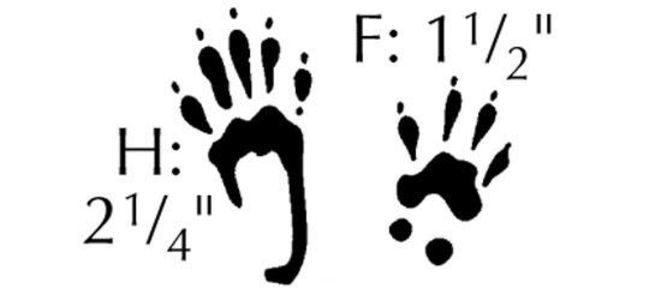
The gray squirrel is an agile climber and a tricky animal to track. Squirrel sign, like chewed nut shells and little holes dug in the ground, is often abundant in their presence. However, clear tracks and footprints are uncommon. Since they are so lightweight and their feet spend more time on unyielding tree bark than soil, finding clear squirrel footprints is an unusual treat.
Squirrels are gallopers, just like rabbits. Their normal track patterns show the rear feet in front of the front feet in a walking and running gait. Watch for more symmetrical foot patterns in squirrel trails to help discern their tracks from the offset front feet of rabbits. Like with other rodents’ feet, look for 4 toes on the front and 5 toes on the rear. Gray squirrel footprints are about an inch long, unless the hind heel pad is showing, which lengthens the rear track. Gray squirrels are found throughout the eastern half of the United States.
Learn how to read tracks, and you’ll learn a new language, one that communicates the hidden stories of the animals that leave the tracks.
Opossum
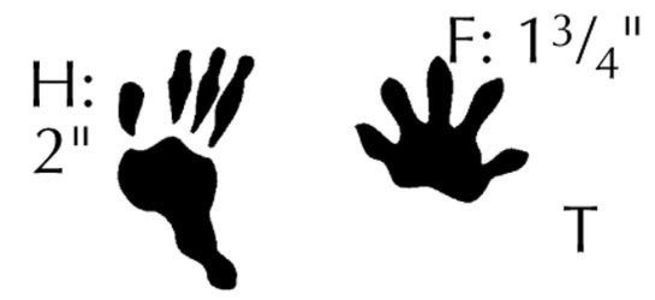
The only North American native marsupial, the opossum has some strange physiology and habits. Opossums have prehensile tails, 50 teeth, opposable “thumbs” on their rear feet, and the females have a pouch. Sometimes you can even frighten them into unconsciousness. These slow moving animals are mostly active at night, when they scavenge for food, which can be literally anything. I once caught an opossum using the tail of a dead opossum for bait.
Keep an eye out for their tracks and trails along waterways. They look similar to raccoon sign, except for the presence of the distinctive rear thumb. The front-feet tracks are often two inches long, and the rear feet are typically three inches long. Opossums are found throughout the eastern states, coastal Pacific states, and coastal Mexico.
Coyote
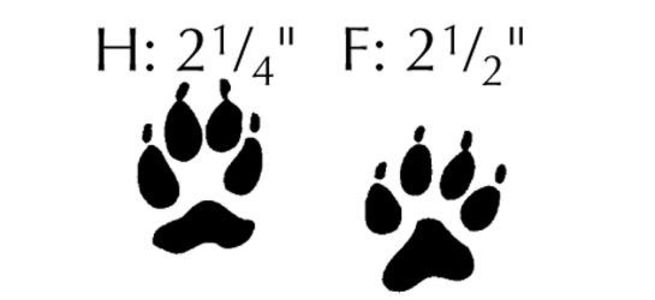
This native canine favors open plains, brushy areas, and woodlands, but can and do live virtually anywhere. Both the four-toed-tracks and scat of coyotes look very much like the tracks and scat of medium-sized dogs. On closer inspection, you’ll typically notice abundant hair and small bones in coyote scat, which is usually absent in domesticated dog droppings.
Coyote tracks are often farther apart than those of a dog with the same size feet or body weight. By trailing these canines, you’ll see that dog trails tend to meander, while coyote trails are straighter and more “purposeful.” The front feet of coyotes are larger than the rear feet, and are roughly two and a half to three inches long. Coyotes are found throughout North America.
Red Fox
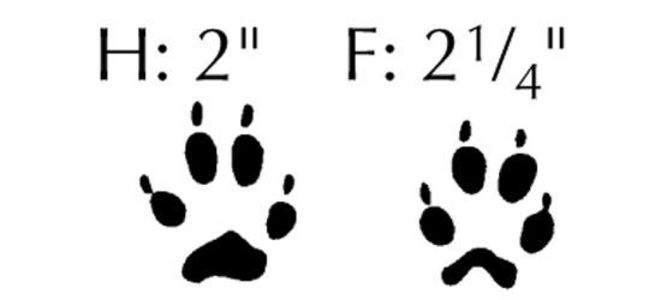
The red fox is a long, lean animal whose bushy tail is longer than half its body length. It’s also one of the most elusive canines in North America. Keen senses allow the red fox to remain undetected by most creatures, including humans. Quite often, the only evidence you’ll find is a few tracks or a single scat deposited in a prominent location. If you hear a yelping in the woods on a springtime evening that sounds like a woman yelling “help,” it’s probably a red fox — though you might check it out, just in case it’s a damsel in distress.
The footprints of a red fox are usually two and a half inches on the front foot and two inches on the rear foot. They are a diagonal walker, just like deer and dogs, and foxes usually place their rear feet in the front footprints. Their tracks and trails often reflect their punchy little steps and quick feet. The red fox can be found throughout the continental US and Canada.
Black Bear
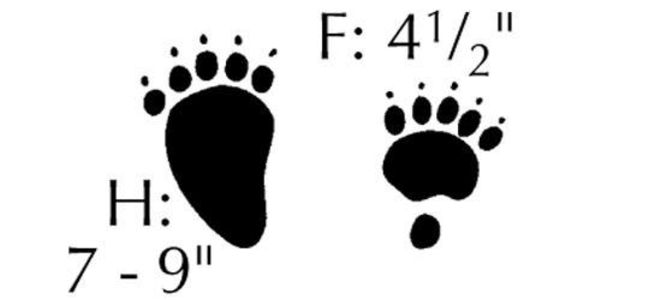
The black bear is an important animal to know how to track, as it represents a danger to any outdoorsman. Though generally shy, a 200- to 400-pound bear can defend itself with surprising speed and great strength if it feels threatened. Black bears are the consummate omnivore, eating fruits, nuts, and insects when those items are available; scavenging on occasion; and hunting other mammals when the opportunity presents itself.
Black bears leave large tracks, with the rear-feet tracks looking almost like human footprints. The front footprints of a black bear average four inches by four inches. The rear feet average three to four inches wide and six to seven inches long when the heel pad imprints. Black bears are found in the mountains, swamps, and forests of the continental US, and are also found throughout Canada.
Bobcat
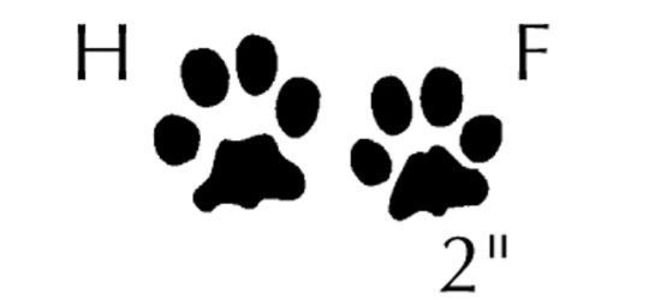
This small wild feline, though not much bigger than a large house cat, can hold its own against many other animals. Bobcats have even been documented killing small deer. The secretive bobcat spends most of its time alone, except when males and females pair off during their mid-winter mating season.
Bobcats are diagonal walkers like deer and canines. This diagonal pattern is so precise that the rear feet land in the front footprints (like with foxes), giving the tracks the appearance of a two-legged walker rather than a four-legged animal. Bobcat tracks are about two inches in diameter and resemble a small dog’s track, except for a small notch in front of the heel pad, dead center in the track. A bobcat’s front feet are slightly larger than its rear feet. Bobcats are present through most of the lower 48 states, though rare in the Great Plains.
Whitetail Deer
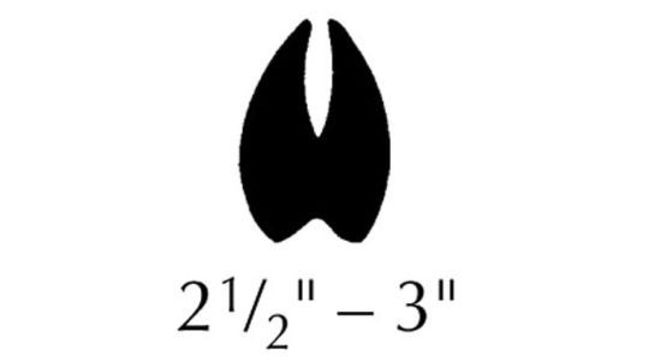
Whitetails are probably the most widely tracked animals in North America, thanks in no small part to their popularity as a game animal. And it doesn’t hurt that they are easier to track than many other animals. The deer’s body weight focuses on relatively small, sharp-edged hooves, which leave impressions in soil types that would hide other tracks. From bedding ovals in tall grass, to piles of pelletized scat, does leave plenty of sign other than tracks. Bucks leave even more sign, which can include scrapes and rubs.
Find a single, heart-shaped track, and you’ll likely find many more tracks and even trails. Whitetails are diagonal walkers, but not as careful as cats and foxes. Look for smaller rear feet hitting near or on top of larger front-foot prints. Whitetail deer tracks average 2 to 3 inches in length. Deer are commonly found through the lower 48 states, southern Canada, and northern Mexico.


